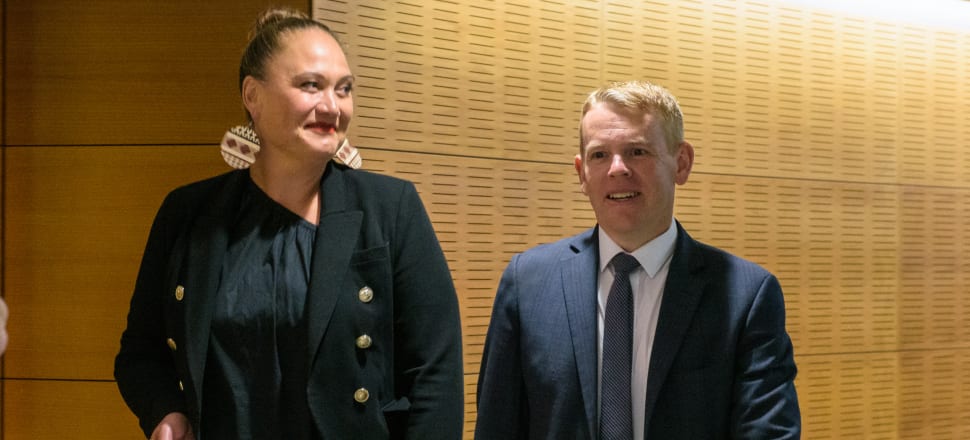
The past few days saw none of the drama, the backstabbing, the leaking and counter-briefing we've come to associate with leadership changes, Marc Daalder reports
The process to anoint a new leader for the Labour Party and the country after Jacinda Ardern announced she'd step down was swift and bloodless.
It took three days and two hours, all told, between Ardern's press conference in Napier on Thursday and the start of Chris Hipkins' in Wellington on Sunday in which he confirmed he had been picked by Labour MPs to succeed her.
The whole thing was over so quickly that the speed left a few of the usual boxes unticked. When he officially becomes prime minister on Wednesday, Hipkins will briefly give up his other portfolios until a full reshuffle is completed - but the recipients of those interim duties weren't all aware.
READ MORE: * Chris Hipkins wants to make politics boring again * The biggest challenges facing PM Hipkins * Hipkins promises focus on ‘bread and butter issues’ * One wedding, two honeymoons and ultimately a funeral
"Grant Robertson will be the leader of the House and the minister for the public service. He doesn't know that yet, but he will now," Hipkins announced to a chorus of laughter.
Those sorts of minor mistakes are the understandable results of such a rapid process to change the leader of the country.
It isn't just speed that was remarkable however - the cleanness of the move was surprising (as well as disappointing for some in the press gallery).
Of all the leadership changes over the past few years, the least damaging one to the party's brand was the switch from Judith Collins to Christopher Luxon. Even that, however, involved Collins trying to oust potential challenger Simon Bridges with a late night demotion, the party caucus then kicking her out the next day and subsequent vocal bids from Bridges and Luxon.
In contrast, Hipkins never announced his candidacy himself, letting Labour do so once it was clear he was the only contender for the job. While frantic speculation suggested other MPs were considering a bid, the party evidently decided a smooth change was preferable. Michael Wood, the supposed rival to Hipkins, was happy to dispel rumours on Sunday that he'd cut a deal with the incoming prime minister in exchange for standing aside.
The deputy spot was also sorted cleanly, with Kiri Allan stepping aside and paving the way for Carmel Sepuloni to adopt the role of deputy prime minister, while Kelvin Davis retains the deputy Labour leader job. As with the top job, there was no backstabbing, no leaking, no counter-briefing here.
The bloodlessness was clear on Sunday, as MPs arrived at Parliament with beaming smiles. Just about every variant of the word "united" was mentioned to reporters.
"Absolutely united," MP Ingrid Leary said of the party. Naisi Chen praised the party's "amazing unity" while Jo Luxton said the caucus was "unified".
Hipkins clearly got the message too, later thanking the caucus for the easy path to leadership and invoking unity once again.
"It has absolutely been the best leadership transition that I have seen in any party in the New Zealand Parliament. I think the maturity that we have seen from my colleagues in the way that they have handled this process has just been so impressive," he said.
"The level of unity and aroha that was in the room this morning when the vote was taken was just amazing."
Ahead of the vote, MPs were tight-lipped about the potential deputy change, saying those were discussions for caucus. It echoed the discipline from Thursday in Napier, when Labour parliamentarians refused to entertain discussions about who might seek the leader role and instead focused solely on celebrating Ardern.
The closest anyone came to a gaffe was Ōhāriu MP Greg O'Connor's bizarre comment to reporters on his way into Parliament that "the Queen is dead, long live the King". Even so, that didn't come close to derailing the proceedings.
After MPs made their way into the Labour caucus room, Ardern and Hipkins walked together down the long red-carpeted hallway, smiling but not stopping to take questions. Within the room, they were greeted with cheers and applause before media were pushed out and the door shut.
It was all over in an hour after that. At one stage the party whips left with a ballot box and returned with flowers. Cheers and singing were heard at a couple more points, before Hipkins and Sepuloni emerged gleefully, promising to reveal what had happened at the press conference later that day.
Even Davis, who had been reconfirmed as deputy leader, didn't stop to share the news. Instead he merely offered a reporter a thumbs up when asked if he was still deputy and walked away without answering follow-ups.
The press conference itself had all the hallmarks of a post-Cabinet press conference - but also wasn't particularly unfamiliar for Hipkins, who had stood at the podium in the Beehive Theatrette for his fair share of Covid-19 briefings. In a way, it looked prime ministerial, but it wasn't completely unique.
A day completely absent of suspense and void of any drama is exactly what Labour was hoping for. A rapid leadership transition means the party isn't seen spending weeks talking about itself.
Now, as Hipkins said from the podium, they can focus on the "bread and butter issues".







